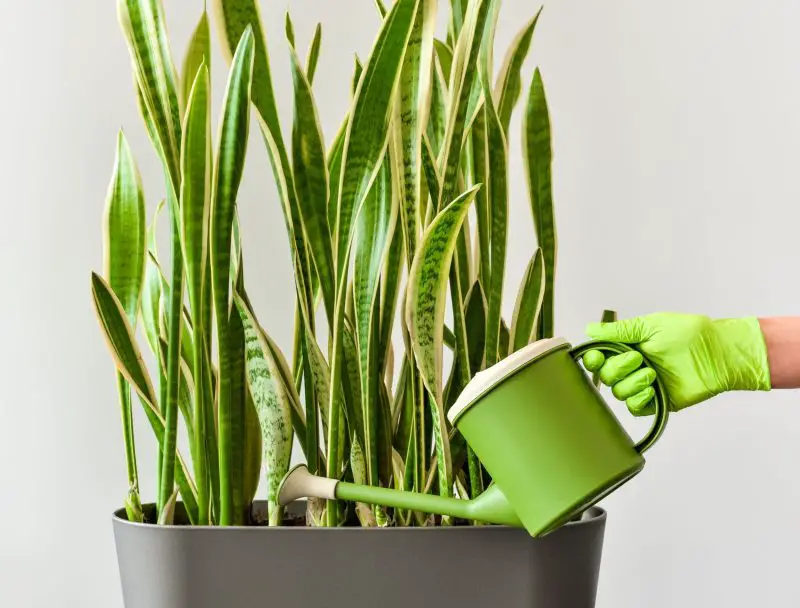Snake plants, scientifically known as Sansevieria or Dracaena trifasciata, are widely loved for their upright sword-like leaves and incredible tolerance to neglect. These plants are often chosen by both novice and experienced plant lovers because of their ability to thrive in various environments. One of the most common questions among snake plant owners is: how often to water snake plant indoors and outdoors? The answer is not as straightforward as it might seem, as it depends on several factors such as location, climate, light exposure, and seasonality.
Understanding the watering needs of your snake plant is crucial to its long-term health. While they are drought-tolerant by nature, overwatering is one of the leading causes of failure with snake plants. Learning when and how to water them appropriately ensures they continue to display vibrant foliage and steady growth. This guide provides in-depth insights into the watering requirements of snake plants grown both indoors and outdoors, helping you create the perfect hydration schedule for your conditions.
Understanding the Natural Adaptation of Snake Plants

Snake plants are native to arid regions of West Africa, where rainfall is minimal and inconsistent. Their thick, fleshy leaves serve as water reservoirs, allowing the plant to endure long dry spells without suffering damage. This natural adaptation explains why snake plants are often grouped among succulent species, even though they aren’t true succulents.
Because of their water-storing capabilities, snake plants are prone to root rot if exposed to too much moisture. Their root system is shallow and sensitive to standing water. In their native habitat, they grow in gritty, fast-draining soil and receive infrequent rainfall. Replicating these conditions in your home or garden is essential to maintaining a healthy plant.
Recognizing the plant’s origins helps guide your watering practices. Snake plants prefer periods of dry soil between waterings. Unlike tropical plants that thrive with regular hydration, snake plants require restraint and observation. Both under-watering and overwatering can be detrimental, but the plant tolerates dryness far better than wetness.
Factors That Influence Watering Frequency
Watering frequency is not a fixed rule. It varies depending on numerous environmental and cultural conditions. For snake plants grown indoors, factors like air conditioning, humidity levels, pot size, and light intensity all influence how often you should water. Outdoor plants are influenced by seasonal rainfall, temperature fluctuations, and soil composition.
Indoor environments typically offer more consistent conditions, but they also reduce evaporation. This means that soil stays moist longer, and snake plants need to be watered less frequently. On the other hand, outdoor snake plants experience natural wind, sunlight, and temperature variations, which increase evaporation and may call for more frequent monitoring.
Seasonal changes play a pivotal role in watering needs. During the active growing season in spring and summer, snake plants use more water and may dry out faster. In fall and winter, growth slows, and the plant requires much less moisture. Adjusting your watering routine according to the season prevents issues like root rot and fungal infections.
Watering Snake Plant Indoors: What to Consider
When grown indoors, snake plants thrive with a minimalist watering schedule. In most average home environments, watering once every two to four weeks is sufficient, depending on ambient temperature and humidity. Rooms with brighter light and higher temperatures may require more frequent checks, while dim or cooler rooms may necessitate longer gaps between waterings.
The type of container used indoors significantly affects how moisture is retained. Plastic pots, for instance, trap more water than unglazed clay pots, which wick moisture away. Snake plants housed in terracotta containers often dry out faster, making them a better option for avoiding overwatering. Always make sure the pot has proper drainage holes to prevent stagnant water accumulation at the bottom.
Checking the soil moisture before watering is a must. Stick your finger about two inches into the soil; if it feels dry, it’s usually safe to water. If it’s still damp, wait a few more days and check again. Using moisture meters is another practical method to monitor soil conditions more accurately. Relying on a set schedule without assessing soil dryness can lead to overwatering and eventual root rot.
Ideal Indoor Watering Practices for Healthy Growth
Indoor snake plants should be watered thoroughly until water exits through the drainage holes. This ensures that the entire root ball receives moisture. After watering, allow the soil to drain completely, and never leave the pot sitting in a saucer of water. Any excess moisture should be discarded to avoid suffocating the roots.
Maintaining air circulation around the plant also helps prevent fungal growth in indoor environments. Placing the snake plant near an east or south-facing window ensures it receives enough indirect sunlight, which helps regulate moisture usage. Low light slows down evaporation, so be cautious when placing snake plants in darker corners of your home.
During the winter months, reduce the frequency of watering drastically. The combination of slower growth and lower temperatures means the plant uses minimal water. Many indoor snake plants may only need watering once a month or even less in winter. Overwatering during this dormant phase is a common mistake that can be fatal to your plant.
Watering Snake Plant Outdoors: Seasonal Adjustments
Outdoor snake plants face a broader range of environmental influences that directly affect their watering needs. In warm climates or during summer, soil dries out more quickly due to heat and sun exposure. During these times, snake plants may require more frequent watering—possibly every week or ten days—depending on how quickly the soil dries.
However, outdoor soil also tends to drain better than indoor potting mixes if planted directly into the ground. Raised beds or rocky garden soil allows excess water to drain away rapidly, which benefits snake plants. If your outdoor snake plant is in a container, ensure it is slightly elevated and has excellent drainage to mimic desert-like conditions.
When temperatures drop or during rainy seasons, snake plants outdoors may require little to no supplemental watering. If natural rainfall is sufficient, additional watering may cause the soil to remain soggy for extended periods. Monitoring the weather and soil moisture becomes especially important to avoid overwatering during these times.
Positioning Outdoor Snake Plants for Success
The success of outdoor snake plants depends not only on how often they are watered but also on where they are planted. These plants prefer full sun to partial shade. In areas with intense midday sun, some dappled shade helps prevent scorching of the leaves, especially during heatwaves.
Soil type matters greatly. Sandy or gritty soils that provide excellent drainage are ideal. If the natural soil is heavy clay or compacted, consider amending it with perlite, coarse sand, or pumice to improve drainage. Snake plants in poorly draining soil, regardless of watering frequency, will struggle with root rot and fungal infections.
Outdoor containers should be weather-resistant and have ample drainage holes. Avoid placing containers directly on concrete or surfaces that prevent water from escaping. Elevating pots slightly with bricks or plant stands helps air circulate and reduces the risk of soggy bottoms, which is essential for outdoor cultivation.
Recognizing Signs of Overwatering and Underwatering
Identifying the symptoms of improper watering is key to making adjustments before serious damage occurs. Overwatered snake plants often exhibit mushy, yellowing leaves that may collapse near the base. The soil will smell musty or sour, indicating the presence of rot. In advanced stages, the roots will turn black and mushy, leading to plant death.
Underwatered snake plants, on the other hand, may have wrinkled or curled leaves with dry, crispy tips. The potting soil may become extremely hard and pull away from the container’s sides. In this condition, water may run off the surface instead of penetrating the root zone, so rehydrating the soil slowly and thoroughly becomes necessary.
Both conditions stress the plant, but underwatering is generally easier to correct. Once an overwatered plant suffers root rot, recovery is more difficult and often requires removing damaged roots, repotting, and applying antifungal treatments. Being observant and adjusting based on your plant’s appearance and soil condition is more effective than rigidly following a schedule.
Tools and Techniques to Improve Watering Habits
Maintaining a watering journal or using mobile gardening apps can help track when and how often you water your snake plant. This is especially helpful for new plant parents who are still learning their plant’s rhythm. Tracking environmental changes and watering outcomes over time helps develop an intuitive understanding of your plant’s needs.
Using self-watering pots is not generally recommended for snake plants unless they’re specifically designed for succulents. These systems can keep the soil too moist for too long. Instead, opt for breathable pots with fast-draining soil and use your hands and eyes to monitor soil and plant health.
Soil moisture meters offer precise insight into water levels below the surface. These inexpensive tools are especially helpful for larger pots or outdoor beds where checking soil moisture manually can be challenging. However, they should be calibrated and used correctly to ensure accurate readings.
Adjusting Watering Based on Climate and Humidity
In dry, arid climates, water evaporates more quickly, and snake plants may dry out faster, especially if exposed to direct sunlight. In such regions, outdoor plants may require more frequent watering than those in humid or coastal environments. On the other hand, high humidity slows down evaporation and can keep soil damp for longer periods, increasing the risk of overwatering.
Indoor snake plants located in homes with central heating or air conditioning may experience artificially dry conditions, which affect soil moisture and leaf health. Using a humidifier or moving the plant away from heat sources helps balance moisture needs. Outdoor plants exposed to wind will also dry out faster than those protected by structures or shrubs.
By paying attention to your specific environmental conditions, you can fine-tune the watering schedule for your snake plant. Climate zones, rainfall patterns, and indoor climate control systems all interact with your plant’s water requirements and should be taken into consideration when developing a routine.
FAQ about How Often to Water Snake Plant
How often should I water a snake plant indoors?
For indoor snake plants, watering every 2–4 weeks is typically sufficient. Always let the soil dry out before watering again.
Can I overwater a snake plant?
Yes, snake plants are very sensitive to overwatering. Excess moisture can cause root rot and yellowing leaves, especially in poorly draining soil.
How do I know if my snake plant needs water?
Check the soil about 2 inches deep. If it feels completely dry, it’s time to water. Wrinkled leaves also indicate dehydration.
Do outdoor snake plants need more water?
Outdoor snake plants may need water more frequently, especially in hot, dry weather. However, good drainage is still essential to prevent rot.
Should I water my snake plant in winter?
Watering should be reduced significantly in winter. Many snake plants only need water once a month or less during their dormant season.
Conclusion
Understanding how often to water a snake plant indoors and outdoors is essential for keeping this hardy and elegant plant healthy. The key lies not in watering frequently, but in observing soil conditions, adjusting to seasonal changes, and respecting the plant’s natural drought-tolerant nature. Whether you grow snake plants in a sunny garden or a shaded living room corner, tailoring your watering routine to the plant’s environment ensures strong roots and lush foliage.
By focusing on drainage, light exposure, pot type, and climate, you can avoid common pitfalls such as overwatering or underwatering. Snake plants reward thoughtful care with resilience and visual beauty, making them one of the most forgiving and graceful additions to any plant collection.






